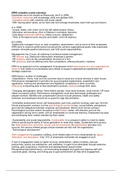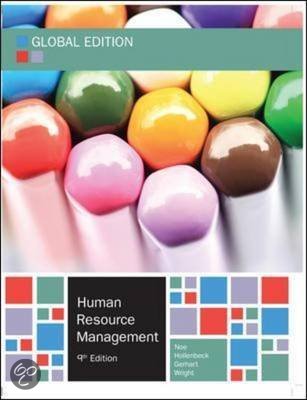HRM complete course summary
Employees are to be viewed as Resources, the R in HRM:
-Economic resources with knowledge, skills and abilities KSA.
-Intangible assets with creativity and social capital.
-With varying asset values, as we have star and average employees, each their ups and downs.
H in HRM:
-Human needs, with which we fit the self-determination theory.
-Motivation and emotions, think of Maslow’s motivation hierarchy.
-Care about employee wellbeing: stress, burnout, satisfaction.
-Think of life beyond work: security and health, work-life balance.
M in HRM:
Traditionally managers focus on task completion, absenteeism, and turnover of their employees.
HRM aims to improve performance & productivity; achieve organisational goals; help employees
prosper; stimulate positive behaviours; and fulfil social responsibilities.
Management has 3 tools, all adhering to evidence-based management:
-HR policies, e.g. Starbucks making each employee a partner.
-HR systems, such as the compensation structure of a firm.
-HR practices, such as offering more than competitors, offering education, etcetera.
HRM is an approach to the management of employees which sees people as a key organisational
resource that needs to be developed and utilised to support organisational operational and
strategic objectives.
HRM faces a number of challenges:
-Globalisation. Home, host and 3rd countries lead to racial and cultural diversity in labor forces.
Performance management must take into account global assignments, expatriation and
repatriation, training and development and legislative compliance in other countries.
Offshoring is exporting jobs to less developed countries; reshoring brings them back.
-Changing demographic trends. More elderly people, more racial diversity, more women. HR must
obtain succession plans. Performance management must face technology challenges and
prepare workers. Benefits and compensation should include pensions, health and safety
schemes, and employers should be on guard for age discrimination.
-Diversified employment forms: self-employment, part-time, portfolio working, start-ups. Not the
formal employment contract, but the psychological contract is key: mutual beliefs, perceptions,
and informal obligations between employer and employee, distinct from formal contract.
Psychological success means focussing on the Protean career: self direction and not the
organisation driving one’s career, with an emphasises on continues learning. Employees hop jobs,
and developing them makes maintaining them easier.
-Sustainability and social responsibility. Sustainability is a company’s ability to meet its needs
without sacrificing the ability of future generation to meet their needs. Sustainable firms pursue
the triple bottom line: economic, social, and environmental. All stakeholders are taken into
account: the various interest groups whose interests are tied with the organisation.
-Technological development.
Work engagement is a positive, fulfilling, work-related state of mind characterised by vigour,
dedication, and absorption. Only 13% of employees worldwide are engaged at work.
A lack of engagement leads to higher turnover, absenteeism, safety incidents, reduces
productivity, quality, job satisfaction, and wellbeing. It ought to be stimulated through selection,
training, goal congruency, incentives and developmental opportunities.
Recognising high performance, communicating strategies and goals and aligning staff with
corporate goals, training, and linking pay to goal achievement all help drive engagement.
, HRM supports business strategy and increases competitiveness; its ability to maintain and gain
market share in its industry. HR basically has 3 product lines when viewed like a business:
-Administrative services and transactions; its classic work of compensation, hiring, and staffing,
emphasising resource efficiency.
-Business partner services: developing effective HR systems and helping implement business
plans, aligning individual and corporate goals, designing systems to ensure needed competencies
are met.
-Strategic partner: contribute to business strategy using human capital.
HRM nowadays focuses less on the administrative tasks and more on its role as a strategic
business partner: HR must be organised to contribute to competitive advantage, e.g. through the
shared service model: a way to organise the HR function that includes centres of expertise,
service centres, and business partners.
As technology takes over part of HRMs administrative role, self-service gives employees access
to HR information such as training and benefits, giving HRM more time to focus on strategy and
the future. Payrolls services often outsourced: the practice of having another company provide
services.
Evidence-based HR demonstrates that HR practices positively influence the firm’s profit and key
stakeholders. HR analytics and big data helps make evidence-based decisions.
Knowledge workers are employees who own the intellectual means of producing a product, and
have many job opportunities: they must be attracted, developed, and retained.
Empowering gives employees responsibility and decision-making authority. A learning
organisation embraces lifelong learning for employees.
Talent management is a systematic planned strategic effort by a company to attract, retain,
develop, and motivate highly skilled employees and managers.
Alternative work arrangements include independent contractors, on-call workers, temporary
workers, and others not employed full-time.
Satisfying stakeholders, not just shareholders, means pursuing the balanced scorecard: a means
of performance measurement giving managers a chance to look at their company from the
perspectives of internal and external customers, employees, and shareholders.
Total quality management TQM is a cooperative form of doing business relying on the talents and
capabilities of both labor and management to continually improve quality and productivity. It’s
about training, meeting the needs of customers, and cooperating to improve quality.
Lean thinking is a process used to determine how to use less effort, time, equipment, and space
to meet customers’ requirements.
A firm’s internal labor force are the current employees, the external labor markets are those
outside the firm actively seeking employment.
Workflow and job analysis
Workflow analysis analysis inputs and processes necessary for producing products prior to
allocating and assigning these tasks to a particular job category or person: it precedes job design.
A job is a set of tasks, duties and responsibilities that constitutes the total work assignment for an
employee.
Job analysis is the process of getting detailed information about jobs: understanding, codifying
and explicating them. Job analysis starts with interviewing, observing, and questionnaires to
come up with a job’s requirements and competencies.
-Key job requirements: tasks, duties, and responsibilities that a job entails.
-Key competencies: job specifications listing the knowledge, skills, abilities and other
characteristics (KSA) that an individual must have to perform a job.
Job-demand resource model
The Job Demand-Resource model JD-R analyses job demands (time pressure, contact with
customers, shift work) and job resources (feedback, rewards, security, support from supervisors).






